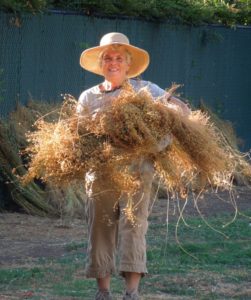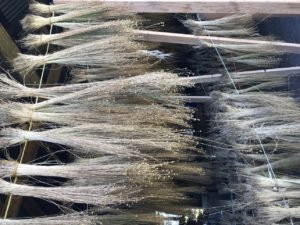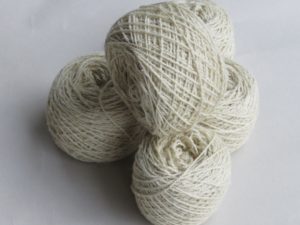Field to Fiber: Chico Flax
By Cathy M Koos
Photo courtesy Chico Flax
I recently had the pleasure of chatting with Sandy Fisher, founder of Chico Flax. Social distancing and a cancelled spring harvest event mandated a lively and broad-reaching phone interview. Sandy and her husband Durl Van Alstyne are the driving force behind this innovative ag venture. Their mission statement is “building a regional fabric one thread at a time.” Chico Flax is “piloting a regenerative agriculture production and social enterprise to Northern California with local community members, farmers, artists and institutions.”
Back in 2012, Sandy, a professional weaver of more than 3 decades, received a call from a Chico local searching for natural fiber clothing. Fires in Bangladesh had cut off her usual suppliers.
Sandy brainstormed with her Mt. Lassen guild colleagues. They determined that wool would be too warm for the inland area and came up with the idea of Chico Cloth, a linen. Not knowing much about the actual growing and processing of linen, Sandy embraced and ran with the idea.
Sourcing seed from the Netherlands, the “Susanne” variety was used the first few years and “Natalie” was introduced last year. Sandy sells an estate blend of seeds on the website, http://www.chicoflax.com .
Sandy told me that her early flax crops were planted in community garden patches all around the area. Due to the hot summers, flax is a winter crop in Chico. Experimental sowing seems to favor the first week in October, allowing the crop to overwinter and benefit from the region’s winter rains. Harvest generally occurs in late March with the plants being pulled from the ground, rather than cut.
Traditionally, flax is dew-retted or rotted in the field. With the lack of dew in Chico, retting is managed in 100-gallon water troughs for 3 days. Then using traditional hand tools, Sandy and other volunteers brake and scutch to separate the outer stems from the fine fibers inside. From there, handfuls of fibers are pulled through a series of hackles to orient the fibers and leave only the fine linen fibers behind.
There are no linen mills in America, so Sandy engaged with the Mendocino Wool and Fiber Mill in Ukiah with that first year’s harvest. Working with Sandy’s flax, Mendo blended Targhee and Romney from the Chico area to create a 35% linen/65% wool yarn. Using natural rosemary and madder dyes from Sandy’s garden yielded gray-green and strong reddish orange yarns, in addition to the natural linen color.
Soon Sandy outgrew the community garden plots. Perhaps a more accurate title for this article would be “orchard to fiber,” as the current flax growing location was formerly an old almond orchard. Pre-emergent residues left from removing the dead trees requires soil rehabilitation, so Sandy is collaborating with Chico State University Ag department to address a 3.75-acre test plot. Awarded a CA Food and Ag grant, they will start with tilling, but aim for no-till in the near future, along with cover crops and mulching to heal the soil. The addition of hedgerows will provide wind and habitat protection.
Sandy was awarded a Patagonia grant under Fiber Shed, and Sally Fox Cottons is collaborating with her on a 60/40 cottolin yarn. A continuing partnership with Chico State includes designing some mechanized tools and a mechanical harvester. In Europe, a good harvester can hand-pull ¼ acre a day, so Sandy’s dream is scattered acres of flax and a co-op mechanical harvester. She is also sourcing small spinning machines.
As we speak today, Chico Cloth is on Sandy’s loom. The forecast is bright with a 100% chance of local linen in our future.


